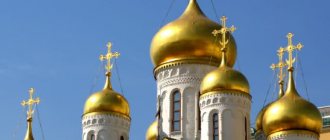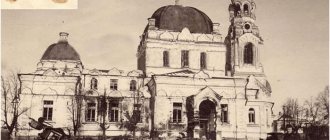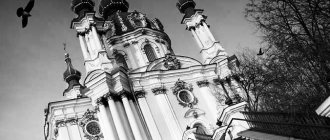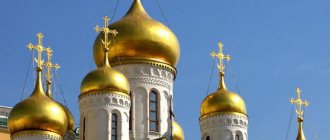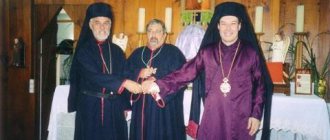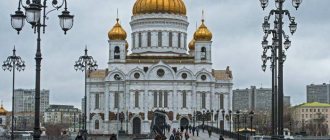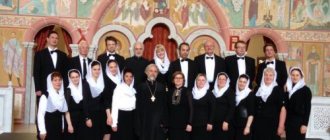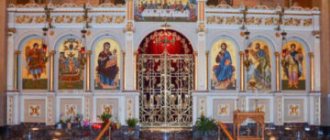What does the term “autocephaly” mean?
Before talking about what an autocephalous Orthodox Church means, we should consider the term “autocephaly” itself. It comes from a Greek word consisting of two roots. The first of them is translated as “himself”, and the second is “head”. It is not difficult to guess that their combined use can mean “self-leadership,” which implies the most complete control of the entire internal life of the church and its administrative independence. In this way, autocephalous churches differ from autonomous churches, which are subject to certain legal restrictions.
The universal church is divided into local (autocephalous) churches not on a national basis, but on a territorial basis. This division is based on the words of the Apostle Paul that in Christ there is no division of people either by nationality or by their social status. All people constitute one “flock of God” and have one Shepherd. In addition, an undeniable convenience is the territorial correspondence of autocephalous churches to the political and administrative borders of states.
Territorial principle of ecclesiastical jurisdiction.
The Universal Church consists of individual local Churches. Local Churches, in turn, include bishoprics (dioceses), and dioceses include parishes. There are other units of administrative-territorial division of the Church: autonomous churches, exarchates, metropolitan districts. This structure of the Church developed during the first centuries of its history, and since then it has remained fundamentally unchanged.
The administrative division of the Church is based on territorial rather than national principles. Under normal conditions, Orthodox Christians of any nationality living in the same territory constitute one parish and are cared for by one diocesan bishop, for, according to the words of the Apostle Paul, in Christ “There is neither Greek nor Jew, neither circumcision nor uncircumcision, barbarian, Scythian, slave , free"
(Colossians 3:11). As it is said, however, in the 34th Apostolic Canon, “it becomes bishops of every nation to be the nobility of the first among them...” - however, the historical context clearly indicates that by “people” in the canon is meant the territory occupied by one or another people. The provinces of the Roman Empire consisted of lands inhabited by tribes that were subsequently Hellenized or Latinized; the names of the provinces preserved the memory of the peoples who once inhabited them: Dacia, Galatia, Thrace, Numidia.
In their territorial demarcation, local Churches are consistent with the political-administrative division, with state and administrative boundaries. In addition to the obvious conveniences, this principle finds indirect justification in the canons themselves. Thus, the 38th canon of the Trullo Council reads: “If a city is re-established or will continue to be established by the royal authority, then the distribution of church affairs should also follow the civil and zemstvo distributions.”
The territorial principle in the delimitation of church jurisdiction also allows for exceptions, which are essentially, in a certain sense, similar to the concept of extraterritoriality in international law. Thus, in ancient times, the heads of some local Churches, in order to maintain constant communication with other Churches, sent their representatives - apocrisiaries - to their metropolitans, exarchs or patriarchs. The monasteries in which the apocrisiaries resided were under the canonical authority of the Church that sent them. These monasteries were called metochs, or farmsteads. During the era of the Turkish yoke, the Eastern Patriarchates established their own metochions under other Churches, especially many in Russia, for collecting alms.
Another deviation from the territorial principle in delimiting jurisdiction is the right of Patriarchal Stauropegia. The word "stauropegia" comes from the Greek words "σταυρος" (cross) and "πηγο" (to erect). The erection of a cross by a bishop at the founding of a church or monastery is a symbol of their canonical dependence on him. The rights of the patriarchal stauropegy lie in the fact that the Patriarch can erect a cross when establishing a monastery or church outside the boundaries of his diocese, thereby including them in his direct jurisdiction. In Russia, during the synodal era, the right of stauropegy was used by the Holy Synod.
In the Byzantine era, the Patriarchs of Constantinople subordinated entire bishoprics located within the metropolitan regions to their jurisdiction. Such bishoprics were called autocephalous archdioceses; autocephaly meant their independence from the local metropolitan.
A unique event in the history of the Church was the resettlement in the 7th century, during the Arab invasion, of the Church of Cyprus to the territory of the Patriarchate of Constantinople in the Hellespont. The Church of Cyprus also retained its autocephaly in the Hellespont. On this occasion, the Trullo Council issued a special 39th rule: “For our brother and co-servant John, primate of the island of Cyprus, together with his people, due to the barbarian invasions, and in order to free himself from pagan slavery, and faithfully submit to the scepter of the most Christian powers, from the mentioned the islands settled in the Hellespont region, through the providence of a man-loving God, and through the diligence of our Christ-loving and pious king; then we decree that the advantages given to the throne above the named man from the God-bearing fathers who once gathered in Ephesus will be preserved unchanged, that the new Justinianople may have the rights of Constantinople, and that the most God-loving bishop established in it will rule over all the bishops of the Hellespont region, and that we decree from their bishops, according to ancient custom."
Rights of autocephalous churches
In order to most fully characterize the essence of autocephaly, it is necessary to take a closer look at the rights that autocephalous churches have. The most important of these is the right to appoint and elect the head of the church by its own bishops. To do this, there is no need to coordinate this or that candidacy with the leaders of other local churches. This is the main difference between autocephalous and autonomous churches. The latter are headed by primates appointed by the church that granted them autonomy.
In addition, local churches have the right to independently issue their own charters. They operate, of course, only in the territory controlled by a given church. Issues related to the structure and management of the church are also resolved internally. The most important of them are submitted to local councils for consideration.
Autocephalous churches have the right to independently consecrate the holy chrism intended for use within the church. Another important right is the possibility of canonizing one’s own saints and drawing up new liturgical rites and chants. The last point has only one caveat - they should not go beyond the framework of dogmatic teachings accepted by the Universal Church.
Local churches are given complete independence in resolving all administrative issues. The same applies to the church court, the right to convene local councils and the possibility of initiating the convening of an Ecumenical Council.
Restrictions placed on the rights of autocephalous churches
Restrictions on the rights of local churches are determined by the principle of church unity. Based on it, all autocephalous churches are identical with each other and are separated only territorially, but not dogmatically or by differences in matters of doctrine. The fundamental principle is the right of the Universal Church alone to interpret religious dogmas, while leaving unchanged the essence of the Orthodox faith.
In addition, the resolution of the most important canonical issues goes beyond the legal framework of local churches and is the responsibility of the Ecumenical Councils. Also, the construction of liturgical life within autocephaly must be generally accepted and be in accordance with the guidelines adopted by the Ecumenical Councils.
Content
- 1 Church administration
- 2 Jurisdictions 2.1 Autocephalous Orthodox churches 2.1.1 Four ancient patriarchates
- 2.1.2 Junior Patriarchies
- 2.1.3 Autocephalous archbishoprics
- 2.1.4 Autocephalous metropolis
- 3.1 Churches of Resistance (True Orthodoxy)
Formation of local churches
The history of the formation of local Churches goes back to apostolic times, when the disciples of Jesus Christ, according to His word, went to various lands to bring people the good news of the Holy Gospel. The churches they founded, due to their territorial isolation, had independence from other churches founded simultaneously with them. The capitals and large cities of these Roman metropolises became the centers of religious life of such new formations.
When Christianity became the state religion, active regulation of the life of local churches began. This historical period (IV-VI centuries) is called the era of the Ecumenical Councils. At this time, basic provisions were developed and adopted regulating the rights of autocephalous churches and a framework was established to limit them. For example, the documents of the Second Ecumenical Council speak of the inadmissibility of extending the power of regional bishops to territories outside the boundaries of their local churches.
It is the documents developed by these Ecumenical Councils that make it possible to give an unambiguous answer to the question of what an autocephalous church means and to avoid ambiguous interpretations.
A law was also adopted according to which a new independent autocephalous church could be created. It is based on the principle: “No one can give more rights than he himself has.” Based on this, either the episcopate of the Universal Church or the episcopate of an already existing and legally recognized local church can create a new autocephalous church. Thus, the continuity of episcopal power from the apostolic was emphasized. Since then, the concept of the “mother church,” or kyriarchal church, has come into use. This is the legal designation of a church whose episcopate has established a new local (autocephalous) church.
Unauthorized establishment of autocephaly
However, history knows many cases of violations of these established rules. Sometimes state authorities declared the churches of their countries autocephalous, and sometimes local episcopates voluntarily withdrew from subordination to the highest authorities and, having elected a primate, declared independence. It should be noted that in most cases there were objective reasons for such actions.
Subsequently, their canonical illegality was corrected by completely legitimate acts, although adopted with some delay. As an example, we can recall the unauthorized separation of the Polish autokyphalists from the Russian Mother Church in 1923. The legality of this act was restored only in 1948, when the church became legally autocephalous. And there are many similar examples.
Currently existing autocephalous churches of Orthodoxy
There are currently fifteen autocephalous churches. All of them are Orthodox, so the frequently asked question about how the autocephalous Church differs from the Orthodox Church naturally disappears by itself. It is customary to list them in the order of a diptych—remembrance at the liturgy.
The first nine are ruled by patriarchs. Among them are the Constantinople, Alexandria, Antioch, Jerusalem, Russian, Georgian, Serbian, Romanian and Bulgarian churches. Following them come those headed by archbishops. These are Cypriot, Hellenic and Albanian. The list of churches that are governed by metropolitans is completed: the Polish, Czech lands and Slovakia, the Orthodox Autocephalous Church in America.
The fifth Russian Church on the list above became autocephalous in 1589. It received its status from the Patriarchate of Constantinople, from which it was dependent until 1548, when a council of Russian bishops elected Metropolitan Jonah as head of the church. The further growing economic and military power of Russia contributed to the strengthening of the political, military and religious authority of our country. As a result, the eastern patriarchates recognized Russia as the fifth “honorable” place.
Recommendations
- Clark, Catherine (2009). Orthodox Church - Simple Guides
(v3.1 ed.). London: Bravo Ltd. ISBN 978-1-85733-640-5. Retrieved August 1, 2015. - "Autocephaly (6 out of 20)." Retrieved August 2, 2015.
- "Eastern Orthodoxy". www.britannica.com
. Britannica. Retrieved July 26, 2015. - Official website of the Serbian Orthodox Church: Pomesne Pravoslavne Crkve
(
Autocephalous Orthodox Churches
) - Official website of the Orthodox Church in America: Worldwide Churches
- "The Idea of the Pentarchy Nella Cristianita." homolaicus.com
. - Kiminas 2009, paragraph 15. sfn error: no target: CITEREFKiminas2009 (help)
- Kiminas 2009, paragraph 19. sfn error: no target: CITEREFKiminas2009 (help)
- "PRAVOSLAV | METROPOLIS". www.orthodox.pl
. Received 2019-01-05. - See the Orthodox Church in America.
- “Η Εκκλησία της Ελλάδος αναγνώρισε την Αυτοκέφαλη Εκκλησία της Ουκρανία ς" [The Greek Church recognized the Autocephalous Church of Ukraine]. eleftherostypos.gr
. Eleutheros Typos. October 12, 2022. Retrieved October 12, 2019. - “The Greek Church recognized the Autocephalous Church of Ukraine (UPD).” Orthodox times
. 2019-10-12. Retrieved 2019-10-12. - “Officially: the Church of Greece recognizes the autocephaly of the Orthodox Church of Ukraine.” Orthodox world
. October 12, 2022. Retrieved October 12, 2022. - “The Patriarchate of Alexandria recognized the autocephaly of the OCU.” www.ukrinform.com
. Ukrinform. 2019-11-08. Retrieved 2019-11-08. - “The Patriarchate of Oleksandriya recognized the OCU. Why is it important." www.bbc.com
. BBC. 2019-11-08. Retrieved 2019-11-08. - “The Patriarchate of Alexandria recognizes the Autocephalous Church of Ukraine (UPD).” Orthodox times
. 2019-11-08. Retrieved 2019-11-08. - “Letter from Patriarch Theodore to the bishops on the recognition of Ukrainian autocephaly.” Orthodox times
. 2019-11-08. Retrieved 2019-11-08. - “The Patriarch of Alexandria recognized the OCU.” www.interfax-religion.ru
. November 8, 2022. Retrieved 2019-11-08. - Online, Εκκλησία (2020-10-24). “Ρχιεπίσκοπος Κύπρου: Η απόφασή μου αυτή υπηρετεί την Ορθοδοξία
.”
ΕΚΚΛΗΣΙΑ ONLINE
(in Greek). Received 2020-10-24. - “The Cypriot Church recognized the Orthodox Church of Ukraine.” Religious Information Service of Ukraine
(in Ukrainian). Received 2020-10-24. - “The Archbishop of Cyprus honored the memory of Metropolitan Epiphanius of Kyiv for the first time (UPD).” Orthodox times
. 2020-10-24. Received 2020-10-24. - Beokovic, Elena (1 May 2010). “Ko su ziloti, Orthodox fundamentalists” [Who are the Zealots, Orthodox fundamentalists]. Policy. Retrieved August 5, 2014.
Equality of all Orthodox autocephalous churches
A very important point is the equality of all autocephalous churches, declared and observed in the practice of interchurch communication. The dogma accepted in Catholicism that the Pope is the vicar of Christ, and that he is, as a consequence, infallible, is absolutely unacceptable in Orthodoxy. In addition, the claims of the Patriarchate of Constantinople to any exclusive rights in the Universal Church are completely rejected.
In this regard, it is necessary to explain the principle by which the ordinal places of certain churches in the diptych are distributed. Despite the fact that these places are called “ranks of honor,” they do not have any dogmatic meaning and are established purely historically. In the order of distribution of seats, the antiquity of the church, the chronological sequence in which it received the status of autocephaly and the political significance of the cities in which the chairs of the leading bishops are located play a role.
Diaspora.
The most serious deviation from the territorial principle in the delimitation of church jurisdiction is the diaspora. In countries where Orthodox Christians do not live in a compact mass, but are scattered among heterodox or non-Orthodox Christians, parishes and even dioceses of different Churches may exist on the same territory. As is known, in the 20th century, when the Orthodox diaspora in America and Western Europe increased many times over both as a result of the resettlement of Orthodox Christians and as a result of the accession of non-Orthodox Christians to Orthodoxy, a number of historically determined problems arose in these countries in the delimitation of church jurisdiction. The Patriarch of Constantinople put forward the doctrine of the special rights of the Ecumenical Throne and, in connection with this, the subordination of the entire diaspora of Western Europe and America to it. Such claims, as completely new, previously unknown to the Church, are rejected by the majority of local Churches. Since ancient times, the following norm has been observed in the life of the Church: a Church that has converted a non-Christian people to Christianity or returned a heretical or schismatic community to Orthodoxy in a territory that is not part of any local Church, becomes for the newly founded Church the Mother Church, the kyriarchal Church. That is why, and not at all because of the 28th rule of the Council of Chalcedon, the Russian Church for centuries was in canonical dependence on the throne of Constantinople.
In the 131st (117th) rule of the Carthage Council it is said: “Several years before this, in this Church, a full council determined that the Churches that were in any limit, before the publication of laws on the Donatists, having become catholic, should belong to those thrones , whom the bishops convinced to join Catholic unity..."
The territory of the Orthodox diaspora may therefore be under the jurisdiction of different local Churches, as is now the case in Western Europe and America. This situation is temporary. The establishment and development of normal church life in the above-mentioned countries should ultimately lead to the formation of new autonomous or autocephalous Churches, but so far this has not happened, the issue of delimiting jurisdiction remains complex, causing disagreements and disputes. When resolving such disputes between autocephalous Churches independent of each other, a number of circumstances should be taken into account: in the 132 (118) rule of the Carthage Council two of them are named - territorial proximity and the will of the church people themselves: “On how catholic bishops are, and those who converted from the country of Donatova will divide the dioceses among themselves. ...If it happens to be a single place; then let it be given to the one to whom it is closest. If it is equally close to both thrones; then let it be done to the one whom the people choose.”
As for territorial proximity, as follows from the 24th (17th) rule of the Council of Carthage, the Numidian Primate lost jurisdiction over the Church of Mauretania of Sitifensky “due to its remoteness.” In the “Pidalion” the interpretation of this rule speaks of its universal meaning. When territorially demarcating the diaspora, the ethnic principle also has a certain significance, but its significance is limited within the framework of the diaspora. Therefore, the Council of Constantinople in 1872 rightly condemned ethnophyletism as an encroachment on the canonical church system.
Autonomous churches and their features
Here it is appropriate to dwell on the state of affairs that developed before 1548, that is, until the moment when the Russian Orthodox Church became autocephalous. Its status in those centuries can be characterized as follows: an autonomous church. It was mentioned above that the main feature of autonomous churches is the lack of the right to independently elect their primate, whom the mother church supplies to them. This significantly limits their independence. And another important aspect of the issue is that the internal and sometimes foreign policy of their states largely depends on who heads the autocephalous independent Orthodox churches.
In fairness, it should be noted that even before Metropolitan Jonah received the title of Metropolitan of Moscow and All Rus', the dependence of the Russians on Constantinople was not too burdensome. The geographic distance from Byzantium, our mother church, played a role here. The churches formed in the territories of the Greek metropolises were in a much worse situation.
1. Brief history of the Russian Orthodox Church.
2. The structure of the Russian Orthodox Church. 3. His Holiness Patriarch of Moscow and All Rus'. 4. Charter of the Russian Orthodox Church. 5. Fundamentals of the Social Concept of the Russian Orthodox Church. 6. Fundamentals of the teaching of the Russian Orthodox Church on dignity, freedom and human rights. 7. Official website of the Russian Orthodox Church. 8. Official website of the St. Petersburg Metropolis. ORGANIZATION OF THE RUSSIAN ORTHODOX CHURCH.The Russian Orthodox Church is a multinational Local Autocephalous Church, which is in doctrinal unity and prayerful and canonical communion with other Local Orthodox Churches. The jurisdiction of the Russian Orthodox Church extends to persons of the Orthodox confession living in the canonical territory of the Russian Orthodox Church: in Russia, Ukraine, Belarus, Moldova, Azerbaijan, Kazakhstan, Kyrgyzstan, Latvia, Lithuania, Tajikistan, Turkmenistan, Uzbekistan, Estonia, as well as voluntarily Orthodox Christians living in other countries join it. In 1988, the Russian Orthodox Church solemnly celebrated the 1000th anniversary of the Baptism of Rus'. In this anniversary year there were 67 dioceses, 21 monasteries, 6893 parishes, 2 Theological Academies and 3 Theological Seminaries. Under the First Hierarchal omophorion of His Holiness Patriarch Alexy II of Moscow and All Russia, the fifteenth Patriarch in the history of the Russian Orthodox Church , elected in 1990, a comprehensive revival of church life is taking place. Currently, the Russian Orthodox Church has 132 (136 including the Japanese Autonomous Orthodox Church) dioceses in various states, more than 26,600 parishes (of which 12,665 are in Russia). Pastoral service is carried out by 175 bishops, including 132 diocesan and 32 vicars; 11 bishops are retired. There are 688 monasteries (Russia: 207 male and 226 female, Ukraine: 85 male and 80 female, other CIS countries: 35 male and 50 female, foreign countries: 2 male and 3 female). The educational system of the Russian Orthodox Church currently includes 5 Theological Academies, 2 Orthodox universities, 1 Theological Institute, 34 theological seminaries, 36 theological schools and, in 2 dioceses, pastoral courses. There are regency and icon painting schools at several academies and seminaries. There are also parochial Sunday schools in most parishes. The Russian Orthodox Church has a hierarchical governance structure. The highest bodies of church power and administration are the Local Council, the Council of Bishops, the Holy Synod, headed by the Patriarch of Moscow and All Russia. The Local Council consists of bishops, representatives of the clergy, monastics and laity. The Local Council interprets the teaching of the Orthodox Church, maintaining doctrinal and canonical unity with the Local Orthodox Churches, resolves internal issues of church life, canonizes saints, elects the Patriarch of Moscow and All Rus' and establishes the procedure for such election. The Council of Bishops consists of diocesan bishops, as well as suffragan bishops who head Synodal institutions and Theological academies or have canonical jurisdiction over the parishes under their jurisdiction. The competence of the Council of Bishops, among other things, includes preparing for the convening of the Local Council and monitoring the implementation of its decisions; adoption and amendment of the Charter of the Russian Orthodox Church; resolving fundamental theological, canonical, liturgical and pastoral issues; canonization of saints and approval of liturgical rites; competent interpretation of church laws; expression of pastoral concern for contemporary issues; determining the nature of relations with government agencies; maintaining relations with Local Orthodox Churches; creation, reorganization and liquidation of self-governing Churches, exarchates, dioceses, Synodal institutions; approval of new church-wide awards and the like. The Holy Synod , headed by the Patriarch of Moscow and All Russia, is the governing body of the Russian Orthodox Church in the period between Councils of Bishops. His Holiness the Patriarch of Moscow and All Russia has primacy of honor among the episcopate of the Russian Orthodox Church. He takes care of the internal and external welfare of the Russian Orthodox Church and governs it together with the Holy Synod, being its Chairman. The Patriarch is elected by the Local Council from bishops of the Russian Orthodox Church who are at least 40 years old, who enjoy a good reputation and the trust of the hierarchs, clergy and people, who have a higher theological education and sufficient experience in diocesan administration, who are distinguished by their commitment to canonical law and order, who have a 'good testimony from outsiders' (1 Tim. 3:7). The rank of Patriarch is for life. The executive bodies of the Patriarch and the Holy Synod are the Synodal Institutions . The Synodal institutions include the Department for External Church Relations, the Publishing Council, the Educational Committee, the Department of Catechesis and Religious Education, the Department of Charity and Social Service, the Missionary Department, the Department for Interaction with the Armed Forces and Law Enforcement Institutions, and the Department for Youth Affairs. The Moscow Patriarchate, as a Synodal institution, includes the Administration of Affairs. Each of the Synodal institutions is in charge of a range of church-wide affairs within the scope of its competence. The Department for External Church Relations of the Moscow Patriarchate represents the Russian Orthodox Church in its relations with the outside world. The department maintains relations between the Russian Orthodox Church and Local Orthodox Churches, heterodox churches and Christian associations, non-Christian religions, governmental, parliamentary, public organizations and institutions, intergovernmental, religious and public international organizations, secular media, cultural, economic, financial and tourism organizations . The DECR MP exercises, within the limits of its canonical powers, the hierarchical, administrative and financial-economic management of dioceses, missions, monasteries, parishes, representative offices and metochions of the Russian Orthodox Church in the far abroad, and also promotes the work of the metochions of Local Orthodox Churches in the canonical territory of the Moscow Patriarchate. Within the framework of the DECR MP there are: the Orthodox Pilgrimage Service, which carries out trips of bishops, pastors and children of the Russian Church to shrines far abroad; The Communication Service, which maintains church-wide relations with secular media, monitors publications about the Russian Orthodox Church, maintains the official website of the Moscow Patriarchate on the Internet; The publications sector, which publishes the DECR Information Bulletin and the church-scientific magazine 'Church and Time'. Since 1989, the Department for External Church Relations has been headed by Metropolitan Kirill of Smolensk and Kaliningrad. The Publishing Council of the Moscow Patriarchate is a collegial body consisting of representatives of Synodal institutions, religious educational institutions, church publishing houses and other institutions of the Russian Orthodox Church. The Publishing Council at the church-wide level coordinates publishing activities, submits publishing plans for approval by the Holy Synod, and evaluates published manuscripts. The Publishing House of the Moscow Patriarchate publishes the 'Journal of the Moscow Patriarchate' and the newspaper 'Church Bulletin' - the official printed organs of the Moscow Patriarchate; publishes the collection 'Theological Works', the official church calendar, maintains a chronicle of the Patriarchal ministry, and publishes official church documents. In addition, the Publishing House of the Moscow Patriarchate is in charge of publishing the Holy Scriptures, liturgical and other books. The Publishing Council of the Moscow Patriarchate and the Publishing House of the Moscow Patriarchate are headed by Archpriest Vladimir Silovyov. The Educational Committee manages a network of theological educational institutions that train future clergy and clergy. Within the framework of the Educational Committee, educational programs for theological educational institutions are being coordinated and a unified educational standard is being developed for theological schools. The chairman of the educational committee is Archbishop Eugene of Vereisky. The Department of Religious Education and Catechesis coordinates the dissemination of religious education among the laity, including in secular educational institutions. The forms of religious education and catechesis of the laity are very diverse: Sunday schools at churches, circles for adults, groups preparing adults for baptism, Orthodox kindergartens, Orthodox groups in state kindergartens, Orthodox gymnasiums, schools and lyceums, catechist courses. Sunday schools are the most common form of catechesis. The Department is headed by Archimandrite John (Ekonomitsev). The Department of Charity and Social Service carries out a number of socially significant church programs and coordinates social work at the church-wide level. A number of medical programs operate successfully. Among them, the work of the Central Clinical Hospital of the Moscow Patriarchate in the name of St. Alexy, Metropolitan of Moscow (5th City Hospital) deserves special attention. In the context of the transition of medical services to a commercial basis, this medical institution is one of the few Moscow clinics where examination and treatment are provided free of charge. In addition, the Department has repeatedly supplied humanitarian aid to areas of natural disasters and conflicts. The Chairman of the Department is Metropolitan Sergius of Voronezh and Borisoglebsk. The Missionary Department coordinates the missionary activities of the Russian Orthodox Church. Today, this activity includes mainly internal mission, that is, work to return to the fold of the Church people who, as a result of the persecution of the Church in the 20th century, found themselves cut off from their fatherly faith. Another important area of missionary activity is opposition to destructive cults. The Chairman of the Missionary Department is Archbishop John of Belgorod and Stary Oskol. The Department for Interaction with the Armed Forces and Law Enforcement Agencies carries out pastoral work with military personnel and law enforcement officers. In addition, the Department's area of responsibility includes the pastoral care of prisoners. The Chairman of the Department is Archpriest Dimitry Smirnov. The Youth Affairs Department at the general church level coordinates pastoral work with youth, organizes the interaction of church, public and state organizations in the spiritual and moral education of children and youth. The Department is headed by Archbishop Alexander of Kostroma and Galich. The Russian Orthodox Church is divided into Dioceses - local churches headed by a bishop and uniting diocesan institutions, deaneries, parishes, monasteries, metochions, religious educational institutions, brotherhoods, sisterhoods and missions. A parish is a community of Orthodox Christians, consisting of clergy and laity, united at the temple. The parish is a canonical division of the Russian Orthodox Church , is under the superior supervision of its diocesan bishop and under the leadership of the priest-rector appointed by him. The parish is formed by the voluntary consent of believing citizens of the Orthodox faith who have reached the age of majority, with the blessing of the diocesan bishop. The highest governing body of the parish is the Parish Assembly, headed by the rector of the parish, who is ex officio the chairman of the Parish Assembly. The executive and administrative body of the Parish Assembly is the Parish Council; he is accountable to the rector and the Parish Assembly. Brotherhoods and sisterhoods can be created by parishioners with the consent of the rector and with the blessing of the diocesan bishop. Brotherhoods and sisterhoods have the goal of attracting parishioners to participate in the care and work of maintaining churches in proper condition, in charity, mercy, religious and moral education and upbringing. Brotherhoods and sisterhoods at parishes are under the supervision of the rector. They begin their activities after the blessing of the diocesan bishop. A monastery is a church institution in which a male or female community lives and operates, consisting of Orthodox Christians who have voluntarily chosen the monastic way of life for spiritual and moral improvement and joint confession of the Orthodox faith. The decision on the opening of monasteries belongs to His Holiness the Patriarch of Moscow and All Rus' and the Holy Synod on the proposal of the diocesan bishop. Diocesan monasteries are under the supervision and canonical administration of diocesan bishops. Stavropegic monasteries are under the canonical management of His Holiness the Patriarch of Moscow and All Rus' or those Synodal institutions to which the Patriarch blesses such management. Dioceses of the Russian Orthodox Church can be united into Exarchates . The basis of such a unification is the national-regional principle. Decisions on the creation or dissolution of Exarchates, as well as on their names and territorial boundaries, are made by the Council of Bishops. Currently, the Russian Orthodox Church has a Belarusian Exarchate, located on the territory of the Republic of Belarus. The Belarusian Exarchate is headed by Metropolitan Philaret of Minsk and Slutsk, Patriarchal Exarch of All Belarus. The Moscow Patriarchate includes autonomous and self-governing Churches . Their creation and determination of their boundaries is within the competence of the Local or Bishops' Council of the Russian Orthodox Church. Self-governing Churches carry out their activities on the basis and within the limits provided by the Patriarchal Tomos, issued in accordance with the decisions of the Local or Bishops' Council. Currently, the self-governing ones are: the Latvian Orthodox Church (Primate - Metropolitan Alexander of Riga and All Latvia), the Orthodox Church of Moldova (Primate - Metropolitan Vladimir of Chisinau and All Moldova), the Estonian Orthodox Church (Primate - Metropolitan Cornelius of Tallinn and All Estonia). The Ukrainian Orthodox Church is self-governing with broad autonomy rights. Its Primate is His Beatitude Metropolitan of Kiev and All Ukraine Vladimir. The Japanese Autonomous Orthodox Church and the Chinese Autonomous Orthodox Church are independent and free in matters of their internal governance and are connected with the Fullness of Ecumenical Orthodoxy through the Russian Orthodox Church. The Primate of the Japanese Autonomous Orthodox Church is His Eminence Daniel, Archbishop of Tokyo, Metropolitan of All Japan. The election of the Primate is carried out by the Local Council of the Japanese Autonomous Orthodox Church, consisting of all its bishops and representatives of the clergy and laity elected to this Council. The candidacy of the Primate is approved by His Holiness the Patriarch of Moscow and All Rus'. The Primate of the Japanese Autonomous Orthodox Church commemorates His Holiness the Patriarch during divine services. The Chinese Autonomous Orthodox Church currently consists of several communities of Orthodox believers who do not have constant pastoral care. Until the Council of the Chinese Autonomous Orthodox Church is held, archpastoral care of its parishes is carried out by the Primate of the Russian Orthodox Church in accordance with the current canons.
Significant restrictions on the freedom of autonomous churches
Autonomous churches, in addition to being governed by a primate appointed by the mother church, were obliged to coordinate their charters, statuses with it, and consult on all any serious issues. They did not have the right to consecrate the ointment on their own. Their bishops were subject to the jurisdiction of the highest court - the court of the kyriarchal church, and they had the right to build their relations with others only through the mother church. All this gave rise to organizational difficulties and hurt national pride.
Intermediate nature of autonomy status
History shows that the status of autonomy of churches is usually temporary, interim. As a rule, over time, they either become autocephalous local Orthodox churches, or, having lost even the appearance of independence, they are transformed into ordinary metropolitan districts or dioceses. There are many examples of this.
Today, three autonomous churches are commemorated in liturgical diptychs. The first of them is the ancient Sinai. It is governed by a bishop appointed from Jerusalem. Next comes the Church of Finland. For her, the Mother Church became the Autocephaly of Constantinople. And finally, the Japanese, for which the Russian Orthodox Church is kyriarchal. The light of Orthodoxy was brought to the islands of Japan at the beginning of the last century by a Russian missionary, Bishop Nikolai (Kasatkin), who was later canonized. For his services to the church, he was awarded the honor of being called Equal-to-the-Apostles. Such a title is given only to those who brought Christ’s teaching to entire nations.
All these churches are Orthodox. As absurd as it is to look for the difference between the autocephalous church and the Orthodox, it is so absurd to talk about the difference between the autonomous and the Orthodox. The need for such an explanation is caused by frequently asked questions about this.

